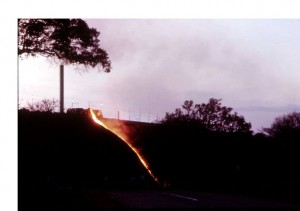Copper cross ingot used as currency in Central Africa
Source of photo: http://www.coupdefoudre.com/TribalArt.html
Kitwe is located in the land of the Lamba people of Zambia. The origins of the Lamba-Lima People of Zambia is from the Bantu stock migrating southwards from the North. Lambas are found in The Democratic Republic Of Congo and in the Copperbelt Province of Zambia.
Dr Francisco Jose Maria de Lacerda, a Portuguese scientist and explorer, mentioned the Lamba people in his diary of 1798.
Zambian penny coin of 1966. Source of photo: http://www.coingasm.com
The Lamba people engaged in Iron Age mining and traded in copper and ivory. (There is evidence of Iron Age mining all the way down to South Africa).There was a booming slave trade locally with the Portuguese and Arab traders from the North East.
The Bechuanaland(of the now Botswana) Exploration Company, the Northern (North of the Zambezi) Copper Company and the British South Africa Company had laid claim to all minerals that would be found in Northern Rhodesia (now Zambia).
The Copperbelt was merely regarded as an access route for the railway line leading from the copper mines in the Congo to South African ports. It wasn’t known, then, that there was a rich seam of copper ore running from the Congo into Northern Rhodesia.
In the 1920’s George Gray, an English prospector was travelling north from the Victoria Falls. He was welcomed by chief Kansanshi who also showed him the mines that local people had worked for several generations.
The discovery of copper at Bwana Mkubwa led more British prospectors to take an interest in the Copperbelt area. Independent prospectors found the deposits at Nkana and at Chambishi.
Pouring of the copper slag – Wusakile at dusk
The deposit at Nkana was near Chief Nkana’s village and was named Nkana Mine. The Chambishi deposit was named after the Chambishi River nearby.
As to the origin of the name KITWE, one of Kitwe’s senior citizens, Mr Cobrey JBK Chiumya explains:
"Kitwe is the central mining town on the Copperbelt of Zambia. Originally, this area was known as Lamba Land – Lamba being the language of the people found in this area.
Before the coming of the white man, the Lamba people found a very big head of a dead animal near the river bank. They called it "Ichitwi" or "Ichitwe" – meaning "a big head."
Eventually, after the coming of the white man and other tribes from neighbouring countries, the name changed to KITWE.
The river which today bears the name Kitwe originates near Chibuluma. It runs east through Nkandabwe township, Buyantanshi, and through the industrial area of town. After running between Parklands and Kitwe Town Center, it joins the Kafue River east of the city.”
Video shows Kaunda City Square and pouring out of copper slag at Wusakile slag dump.
See Related Post: The History Of Kitwe
REFERENCES
- http://books.google.co.uk/books?id=Ih4NAQAAIAAJ&pg=PA40&dq=kitwe&source=gbs_toc_r&cad=4#v=onepage&q=kitwe&f=false
- http://travelblogimages.bloguez.com/travelblogimages/1243409/Kitwe
- How The Northern Rhodesia Coppers Were Found
- Iron Age Mining In The Transval
- The Lamba-Lima People Of Zambia on Facebook
- http://www.jstor.org/pss/716715
- http://books.google.co.uk/books?id=X4VmAWdXPD0C&pg=PA350&lpg=PA350&dq=the+lamba+people&source=bl&ots=uxjfAI1TxV&sig=XjshLt6QVzhzPq70LgSk4YOyRDw&hl=en&ei=Upo_TcbBHJCp8QPY7anPBA&sa=X&oi=book_result&ct=result&resnum=5&ved=0CC4Q6AEwBDge#v=onepage&q=the%20lamba%20people&f=false






Excellent history off the copper belt province or the lambaland
Thanks.
The narrative was not well researched and a lot of facts are amiss. Good read though. Pick research materials from Former Wusakile and Chamboli dwellers on Facebook
Hi Omandi. Thanks for your contribution and for pointing us to Former Wusakile and Chamboli Dwellers on Facebook. It’s a great resource, particularly Mr Kenneth Ngalamika’s posts(“The Name Wusakile” – 26 June 2021, and “THE LAMBA PEOPLE OF THE COPPER BELT OF ZAMBIA” – 25 June 2021). When a community shares stories and knowledge, a consensus builds up and everybody benefits. We will get a better historical perspective this way.
Can you point out the missing information?
Because from what I have seen the writer concentrated mostly on the copper belt town of Kitwe as opposed the the entire Lambaland.
The finding of the animal head is covered, and the chief of the area.
One thing of the greater importance is that the Lamba people migrated to the land called ilamba between 1400 to 1500 and please note no any other tribe was present in that land.
The rest of the tribes came in search of employment in the 1930s and 1940s and no one will change that history to suit them
The work is just fine. And there is no way one can exhaust everything in one space.